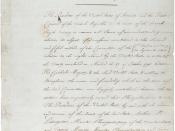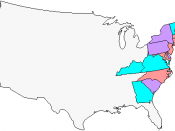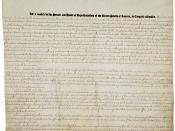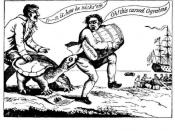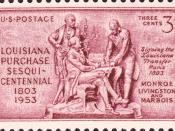The Republicans Jefferson and Madison, and the Federalists, mainly Hamilton, hated each other. They constantly fought over power of the U.S., and were classified into two groups, Republicans were strict and Federalists were loose constructionists. This was a fairly accurate statement most of the time, but occasionally one of them would change from loose to strict, or vice versa.
America was having a huge burst of immigrant population during the late 1790's, and this deeply troubled the Federalists. They were mostly afraid that the immigrants, mainly the French and Irish, were plotting against Britain. They passed the Alien and Sedition Acts in 1798, giving them the right to arrest and deport any foreigners that they thought were a threat to the nation. This broad interpretation of the Constitution was more for the federal government than it was for states rights. The Republicans replied with the Virginia and Kentucky Resolutions, adopted by the Kentucky legislature in 1798.
Written by Thomas Jefferson himself, they were a severe attack on the Federalists' broad interpretation of the Constitution, which would have extended the powers of the national government over the states. The resolutions declared that the Constitution merely established a compact between the states and that the federal government had no right to exercise powers not specifically delegated to it under the terms of the compact; should the federal government assume such powers, its acts under them would be illegal and therefore void.
In Jefferson's letter to Granger, he shows a major belief in strict constructionism. He acknowledges the fact that one central government is too small for such a large country. He supports the idea that the states should be independent, but obeying the constitution. America gets larger when Jefferson made the Louisiana Purchase in 1803. It seemed like a good deal that he couldn't turn down, $15 million for all that land. The only problem was that it wasn't entirely constitutional for him to purchase all this land, with all these people living on it, and if the Federalists knew they would jump on the chance to accuse him of being unconstitutional. So Jefferson went to Congress asking if he could purchase the land and they asked to see proof that he purchased the land. He didn't have it with him, so he became a loose constructionist and re-interpreted the executive privilege.
The cartoon is a Federalist document that shows an obvious opposition to Jefferson's Embargo Act of 1807. The act was intended show the neutrality of America and to stop the seizing of American ships by the British navy. It depicted the act as Orgrabme, the American Snapping- nor France greatly depended on American goods, so it was mostly just something turtle that did nothing but annoy traders. The pro-British Federalists didn't mind that it was hurting France, but they hated that it was also hurting England. However, neither Britain nor France greatly depended on American goods, so it was mostly something for the Federalists to blame the Republicans for.
Republicans and Federalists always keep their same ideas and beliefs about America. They only change their beliefs when they absolutely need to, as Jefferson used loose constructionism for the Louisiana Purchase. He used loose constructionism to obtain his goal of expanding the nation, as strict constructionists want. It is fairly accurate to say that the Republicans are strict constructionists while the Federalists are loose.
